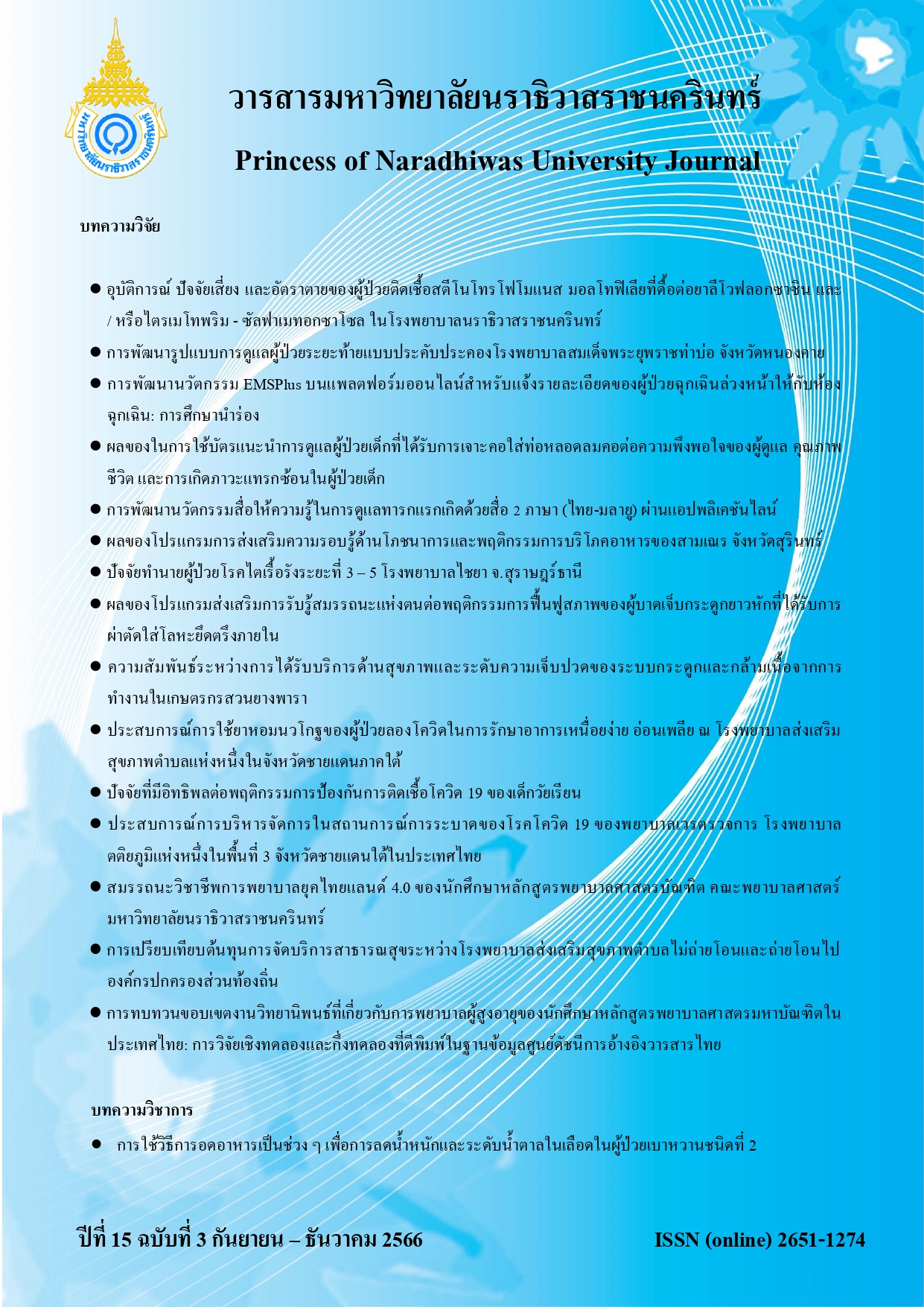The Effect of Perceived Self-Efficacy Promoting Program on Rehabilitation Behavior in Patients with Long Bone Fracture Receiving Internal Fixation
Keywords:
Perceived self-efficacy, Rehabilitation behavior, Long bone fractureAbstract
This study used a pre-post design with one sample group, examined the effect of perceived self-efficacy promoting program on rehabilitation behavior in patients with long bone fracture receiving internal fixation. Purposive sampling was used in this study to select a sample of 30 participants. The experimental approach included lectures, case study analysis, and expert-led rehabilitation practice. Assessment of rehabilitation behavior was used as the instrument for data collection. Validity testing with three experts was equal to one, and reliability was tested using the test-retest method with ten participants who have characteristics that are approximately equal to the sample size of 0.75. Pair-t-test was used in data analysis.
The findings showed that participants had significantly higher average scores of rehabilitation behavior in patients with long bone fracture receiving internal fixation after participating in perceived self-efficacy promoting program than before participating in the program (t = -14.930, p 0.001).
The results should be disseminated, and encouraged to the relevant organizations for utilizing this program to raise the capacity of the professionals who look after patients with long bone fractures receiving internal fixation.
References
Bandura, A. (1994). Self-efficacy. In V. S. Ramachaudran (Ed.), Encyclopedia of human behavior (Vol. 4, pp. 71-81). New York: Academic Press. (Reprinted in H. Friedman [Ed.], Encyclopedia of mental health. San Diego: Academic Press, 1998).
Boonmak, P., Suraseranivongse, S., Pattaravit, N., Boonmak, S., Jirativanont, T., Lertbunnaphong, T., ... & Wittayachamnankul, B. (2022). Simulation-based medical education in Thailand: a cross-sectional online national survey. BMC Medical Education, 22(1), 1-9.
Chansungnoen, J. (2021). Simulation Based Learning: Nursing Education. Journal of Southern Technology, 14(1), 145-153.
Chueybuddha, C., Sripaoraya, S., & Yowsong, P. (2019). The Effect of Self- Efficacy Promotion Program to Re-fracture Behavior in Patients with Femoral Fractures Receiving Internal Fixation in Krabi Hospital. Krabi medical journal, 2(2). 9-16.
Daniel, S. (2006). Free statistics calculators’ version 4.0. Retrieved June 28, 2017 from https://goo.gl/LvsyzG G
Grove, S. K., Burns, N., & Gray, J. (2012). The practice of nursing research: Appraisal, synthesis, and generation of evidence. Elsevier Health Sciences.
Harty, J. A., McKenna, P., Moloney, D., D'Souza, L., & Masterson, E. (2007). Anti-platelet agents and surgical delay in elderly patients with hip fractures. Journal of Orthopaedic Surgery, 15(3), 270-272.
Jittwongpan, T., Supametaporn, P., & Chairat, R. (2021). Effects of a Self-efficacy Enhancement Program on Preventive Behaviors and Body Mass Index in People at risk of diabetes. Nursing Journal, 48(4), 243-242.
Kardosod, A. (2019). Postoperative Care for Intertrochanteric Fracture Patients Undergoing Open Reduction and Internal Fixation (ORIF). Nursing Journal, 46(4), 183-192.
Khachat, S., & Phothong, P. (2022). Development of Simulation- Based Learning with Standardized Patient Model to Promote Knowledge, Perceived Self-Confidence and Therapeutic of Communication Skill. The Journal of Boromarjonani College of Nursing, Suphanburi, 5(2), 47-60.
Khampiuvpun, C. (2021). Effectiveness of a Promoting Program on Rehabilitation of Closed Fracture a Leg Patients with Internal Fixation Surgery, Koh Samui Hospital. Journal of MCU Nakhondhat, 8(5), 263–278.
Kröger, I., Müßig, J., Brand, A., Pätzold, R., Wackerle, H., Klöpfer-Krämer, I., & Augat, P. (2022). Recovery of gait and function during the first six months after tibial shaft fractures. Gait & Posture, 91, 66-72.
Naradhiwas Rajanagarindra Hospital. (2021). Statistics of fracture patients’ administration at the orthopedic ward. Bureau of Statistics, Narathiwat Rajanagarindra Hospital. (in Thai).
Pradeep, A. R., KiranKumar, A., Dheenadhayalan, J., & Rajasekaran, S. (2018). Intraoperative lateral wall fractures during Dynamic Hip Screw fixation for intertrochanteric fractures-Incidence, causative factors and clinical outcome. Injury, 49(2), 334-338.
Raju, K., Smith, T. O., Hing, C. B., Solan, M. C., & Nielsen, D. M. (2018). Surgical versus conservative interventions for treating tibial shaft fractures in adults. The Cochrane Database of Systematic Reviews, 2018(4).
Simsiriwat, W., Junprasert, S., & Krungkraipetch, N. (2017). Effects of self-efficacy promotion on knowledge, perceived self-efficacy and promoting thalassemia control behavior among Bangkok health volunteers. Journal of Faculty of Nursing Burapha University, 25(2), 94-104.
Suksrisai, B., Linhavong, J., Manonom, S., & Manorangsan, S. (2020). Prevalence and Factors Affecting First and Recurrent Hip Fracture in the Elderly: A Retrospective Study from Inpatients at Thammasat University Hospital. Thammasat Medical Journal, 20(4), 275-285.
Supanpiew, T., Intaranongpai, S., & Suwannimit, A. (2016). Effects of Self Efficacy for Modification of Health Behavior to Prevent Diabetes in Risk Group through Community Participation. Research and Development Health System Journal, 9(3). 162-172.
World Health Organization. (2018). Global status report on road safety 2018. World Health Organization. Retrieved April 29, 2021 from https://apps.who.int/iris/bitstream/handle/ 10665/276462/9789241565684-eng.pdf
World Health Organization. (2021). Falls. Retrieved April 29, 2021 from https://www.who.int/news-room/fact-sheets/detail/falls
Ziegler, P., Schlemer, D., Flesch, I., Bahrs, S., Stoeckle, U., Werner, S., & Bahrs, C. (2017). Quality of life and clinical-radiological long-term results after implant-associated infections in patients with ankle fracture: a retrospective matched-pair study. Journal of orthopaedic surgery and research, 12(1), 1-7.
Downloads
Published
How to Cite
Issue
Section
License
Copyright (c) 2023 Princess of Naradhiwas University Journal

This work is licensed under a Creative Commons Attribution-NonCommercial-NoDerivatives 4.0 International License.




